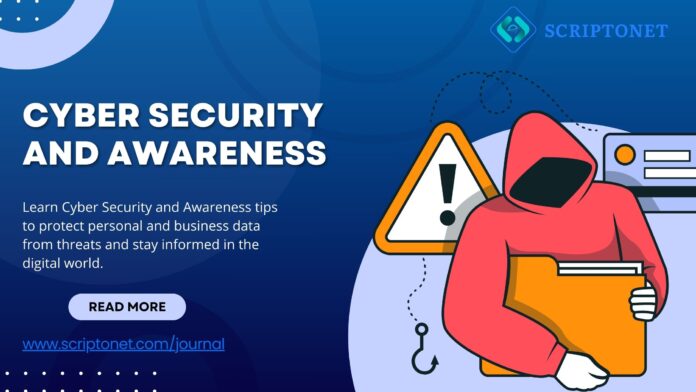Introduction
Understanding Cyber Security and Awareness is more important than ever for both individuals & businesses. Cybersecurity involves various methods, tools, and procedures that aim to safeguard computer systems, networks, and information from unauthorized intrusion, harm, or interference. It’s a multifaceted field addressing threats like malware, phishing, ransomware & Denial-of-Service (DoS) attacks. Effective cybersecurity involves a layered approach, including Firewalls, Intrusion Detection Systems (IDS), Antivirus Software & robust Access Controls. Crucially, it also demands continuous monitoring, risk assessment & incident response planning to mitigate vulnerabilities & ensure business continuity.
Cybersecurity awareness is the understanding & recognition of these threats by individuals & organizations, fostering a culture of vigilance. It emphasizes the importance of secure behaviors, such as strong password management, recognizing phishing attempts & avoiding suspicious links or downloads. Awareness training empowers users to become the first line of defense against cyberattacks, reducing the likelihood of human error that can lead to security breaches. Regular updates on emerging threats & best practices are vital to maintain a proactive stance, ensuring individuals & organizations remain informed & resilient in the face of evolving cyber risks.
Preventing Common Cyber Threat
Common cyber threats pose significant risks to individuals & organizations alike. Phishing attacks, often disguised as legitimate communications, aim to steal sensitive information through deceptive emails, messages or websites. Malware, including viruses, worms & spyware, infiltrates systems to corrupt data, steal information or disrupt operations. Ransomware encrypts critical data, demanding payment for its release, causing significant financial & operational disruption. Denial-of-service (DoS) & Distributed Denial-of-Service (DDoS) attacks overwhelm systems with excessive traffic, rendering them unavailable to legitimate users. Additionally, Man-in-The-Middle (MiTM) attacks intercept communications to eavesdrop or manipulate data, while SQL injection & Cross-Site Scripting (XSS) exploit vulnerabilities in web applications to gain unauthorized access.
Preventing these threats requires a comprehensive & layered security strategy. User awareness & training are paramount, educating individuals to recognize phishing attempts, avoid suspicious links & practice safe browsing habits. Enforcing strict password rules, utilizing multi-factor authentication, and imposing access controls help prevent unauthorized entry to important systems and data. Regular software updates & patching of vulnerabilities are crucial to mitigate known exploits. Endpoint protection solutions, including antivirus & anti-malware software, provide real-time threat detection & prevention. Firewalls & Intrusion Detection/Prevention Systems (IDPS) monitor network traffic, blocking malicious activity & detecting suspicious patterns. Network segmentation & data encryption further enhance security by isolating critical systems & protecting sensitive information.
Furthermore, robust incident response plans & regular backups are essential for minimizing the impact of successful cyberattacks. Regular security assessments & penetration testing help identify vulnerabilities before they can be exploited. Staying informed about emerging threats & best practices through security advisories, industry publications & continuous monitoring is crucial for adapting to the evolving cyber landscape.Implementing Security Incident & Event Management (SIEM) systems helps centralize & analyze security logs, providing valuable insights into potential threats & enabling proactive response. Collaboration & information sharing with industry peers & law enforcement agencies can also contribute to a stronger collective defense against cyber threats.
Cyber Security and Awareness: Best Practices for Online Safety
Online safety is paramount in today’s digital age, requiring a combination of technical measures & mindful practices. Creating robust passwords that are different for every account and utilizing a trustworthy password management tool are essential practices. Enabling Multi-Factor Authentication (MFA) whenever possible adds a crucial second layer of security, significantly reducing the risk of unauthorized access. Vigilance against phishing attacks is essential; scrutinize emails, messages & links for suspicious content, verifying sender authenticity before clicking or providing information. Keeping software, operating systems & applications updated ensures that known vulnerabilities are patched, minimizing the risk of exploitation. Regularly scan for malware & viruses with reputable antivirus software & keep firewalls active to monitor & control network traffic.
Practicing safe browsing is essential to guard against online dangers. Avoid suspicious websites & downloads & be cautious about the information you share online. Adjust privacy settings on social media platforms to limit public access to your personal data. Regularly backup important data to an external drive or cloud service, safeguarding against data loss from malware, hardware failure or accidental deletion. When using public Wi-Fi networks, consider utilizing a Virtual Private Network (VPN) to encrypt your connection, protecting your data from potential eavesdropping & interception. Be aware of the risks associated with public computers & avoid accessing sensitive information on them.
Education & awareness are key to maintaining online safety. Stay informed about emerging cyber threats & best practices through reputable sources. Share this knowledge with family, friends & colleagues, fostering a culture of online safety. Teach children about safe online practices, including the dangers of sharing personal information & interacting with strangers online. Practice caution when clicking on links in emails & messages, especially from unknown senders. Be mindful of the permissions you grant to apps & websites & regularly review & revoke unnecessary permissions. Regularly review your online accounts for suspicious activity & report any anomalies promptly. Cultivating a healthy skepticism & staying proactive in protecting your digital footprint are essential components of online safety.
The Role of Cyber Security and Awareness in Protecting Personal & Organizational Data
Cyber awareness acts as a critical shield, protecting both individual & organizational data from the ever-present threat of cyberattacks. It’s not merely about technical knowledge, but about fostering a mindset of vigilance & responsibility. For individuals, this translates to understanding the risks associated with daily online activities, from social media interactions to online banking. Recognizing phishing attempts, practicing safe browsing habits & understanding the importance of strong, unique passwords are fundamental aspects of personal cyber awareness. It empowers individuals to make informed decisions, minimizing the risk of identity theft, financial loss & data breaches.
Within organizations, cyber awareness becomes a crucial component of a robust security strategy.Workers are frequently the primary defense against cyber threats, and their knowledge of security procedures and top practices is crucial.Cyber awareness training should encompass a wide range of topics, including phishing recognition, malware prevention, data handling procedures & incident reporting. Regular training sessions, simulations & awareness campaigns reinforce these principles, creating a culture where security is ingrained in daily operations. By empowering employees to recognize & report suspicious activities, organizations can significantly reduce the risk of successful cyberattacks, protecting sensitive data, maintaining business continuity & safeguarding their reputation.
The impact of cyber awareness extends beyond preventing direct attacks. It also fosters a culture of data privacy & responsible information handling. Individuals who are aware of the risks are more likely to protect their own data & respect the privacy of others. Companies that focus on cyber awareness show dedication to safeguarding data and establishing confidence with their clients and partners. In an interconnected world, where data breaches can have far-reaching consequences, cyber awareness is not just a best practice, but an essential component of personal & organizational security. It’s a continuous process of education, vigilance & adaptation to the evolving cyber landscape, ensuring that data remains protected & individuals & organizations remain resilient in the face of cyber threats.
Conclusion
In conclusion, cyber security and cyber awareness are inextricably linked, forming a vital defense against the ever-evolving landscape of digital threats. Protecting personal & organizational data requires a multifaceted approach, encompassing technical safeguards & a culture of vigilance. Cyber awareness empowers individuals & employees to recognize & mitigate risks, transforming them from potential vulnerabilities into active defenders.By fostering a deep understanding of common cyber threats, best practices for online safety & the importance of data privacy, we can collectively strengthen our resilience against cyberattacks. Continuous education, proactive measures & a commitment to staying informed are essential for navigating the complexities of the digital world & ensuring the safety & security of our data.
Frequently Asked Questions (FAQ)
What are the most common types of cyberattacks & how can I recognize them?
Common attacks include phishing (deceptive emails), malware (harmful software), ransomware (data encryption for ransom) & social engineering (manipulation). Recognize them by scrutinizing emails for suspicious senders & links, avoiding unknown downloads & being wary of requests for personal information.
How can I create strong passwords & manage them effectively?
Use long, complex passwords with a mix of uppercase & lowercase letters, numbers & symbols. Consider using a password manager to generate & store unique passwords securely. Activate Multi-Factor Authentication (MFA) to increase security measures.
What steps can I take to protect my personal information online, especially on social media & during online shopping?
Adjust privacy settings on social media, be cautious about sharing personal details & only shop on secure websites (look for “https” & a padlock icon). Avoid clicking on suspicious links & regularly review your online accounts for unauthorized activity.
How often should I update my software & devices & why is it important?
Make sure to update your software and devices promptly when updates become available. Updates often include security patches that fix vulnerabilities, protecting you from known threats. Delaying updates leaves you vulnerable to exploits.
What should I do if I suspect I’ve been a victim of a cyberattack, such as identity theft or a data breach?
Immediately change your passwords, notify relevant institutions (banks, credit card companies), report the incident to authorities & monitor your accounts for suspicious activity. Think about adding a fraud alert to your credit history.


